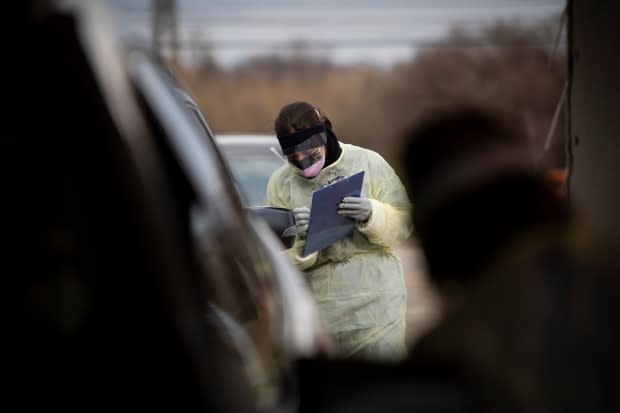Ontario won't specify COVID-19 'hot spots' even as premier urges testing

Premier Doug Ford is pleading with people who live in Ontario's COVID-19 "hot spots" to get tested for the virus — but officials won't specify which neighbourhoods have been hardest hit.
Ford mentioned the province's coronavirus hot spots multiple times during his daily news conference Monday. He said the government is able to measure them by postal code, and that some areas are "lighting up like a Christmas tree."
"We want to encourage people in the hot spots … please get tested," Ford said.
But that data has not been made public. CBC News has requested a breakdown of cases by postal code, but Hayley Chazan, spokesperson for the provincial minister of health, would only say that Ontario's hardest-hit regions are in Toronto, Peel Region and Windsor-Essex County.
Ford elaborated slightly Monday afternoon, saying "parts" of those regions were most affected. He also mentioned parts of Brampton, north Etobicoke and Scarborough.
According to the latest data from the province, Toronto-area public health units account for 64.8 per cent of Ontario's cases.
WATCH | Premier Doug Ford discusses Ontario's COVID-19 hot spots
"We're going to get people out where the hot spots are and get them tested," Ford said, though he did not elaborate on exactly how that would happen.
Ford said the province plans to launch "the next steps" of its testing strategy in the coming days. The first steps of that plan began this weekend, he said, with testing of hospital workers — symptomatic or not — and inmates and staff in correctional facilities.
"I want as many people tested as possible," he said.
But that hasn't been happening. Ontario has routinely been missing its testing target in recent days, with just 8,170 tests processed since the province's last daily update.
That's far below the benchmark of 16,000 per day and nowhere near the almost 20,000 tests Ontario has the capacity to handle on any given day. The backlog of tests waiting to be processed is sitting at 3,883.
Ford, who has repeatedly stated he wants to see more testing, said Monday the province's plan "will take time to fully ramp up."
Avoiding stigma
But the province might be reluctant to name the hot spots because of the stigma that could cause, says Dr. David Fisman, professor of epidemiology at the University of Toronto's Dalla Lana School of Public Health.
"I think we know more than what is being discussed publicly about where the hot spots are, particularly within the [Toronto area]," Fisman, who is also a physician at Michael Garron Hospital, said Monday on CBC Radio's Metro Morning.
"I think there are some very important discussions happening internally in public health agencies about stigma. Because this happens again and again with infectious diseases — where you draw a circle around a place that has higher rates of infection, and all of a sudden folks say 'that's where the infectious people are,'" he said.
"I think there's a great desire not to create that kind of dialogue or that kind of rhetoric in Toronto."

Fisman also said that health units in particularly affected areas need help to snuff out the virus. That would include support for people in dense areas who might have trouble physically distancing, protective equipment for front-line workers, and mobile testing for people who have difficulties getting to a testing centre.
"I don't think this is about enforcement or further stigmatization," he said.
"I think this is about supporting vulnerable parts of the GTA so that we can get this done."

